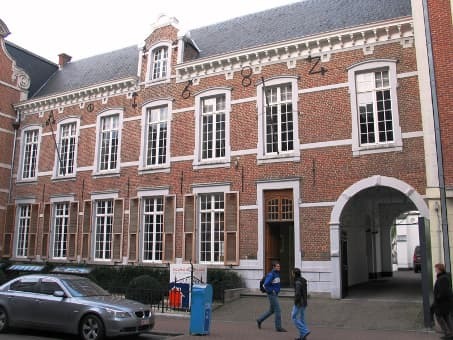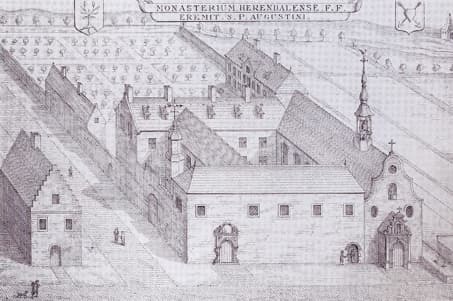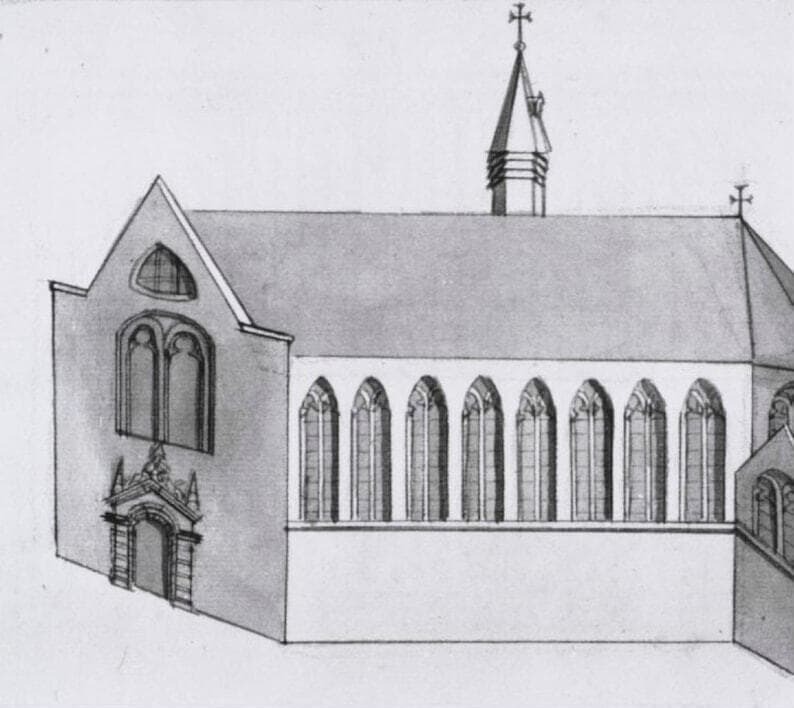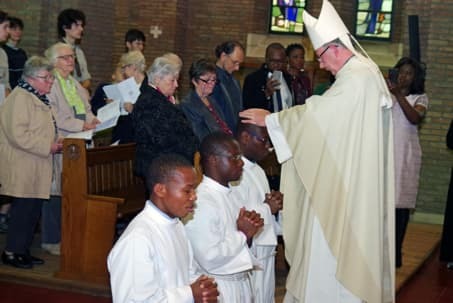History of the augustinians in Belgium

The origin
Traditionally, the Hasselt hermitage has been regarded as the oldest settlement of the Augustinians in the Netherlands and the year 1236 is mentioned. This is not entirely certain. During the 13th and 14th centuries, friaries arose in, for example, Enghien, Maastricht, Ghent, Mechelen, Bruges and Leuven. The first convents of our order in the Netherlands were originally assigned to the German and French order provinces. The river, the Scheldt, formed the natural border between the two provinces because the area on the left belonged to the Frankish empire and on the right to the German empire. The convents in the county of Flanders west of the Scheldt, namely the convents of Ypres, Bruges and Ghent, belonged to the French province. The provincials of the German province took action in the other cities. When the number of convents in the German province rose to 80 between 1304 and 1314, it was necessary to further divide the convents into provinces.

Four provinces were created: the Rhine-Swabian with Switzerland, Swabia, and the South Rhine region; The Cologne-Belgian province with the Rhine region from Mainz, Belgium, the Netherlands and French Flanders; the Saxon-Thuringian with Franconia, Thuringia and northern Germany and finally The Bavarian Province, with Bavaria, Austria, Styria, Carinthia, Silesia, Bohemia and Poland. The Augustinians were active in preaching in their own churches and beyond, but also in science. The first university of the Low Countries was founded in the refectory of the Augustinians in Leuven and several confreres made their contribution to the university.
Following the joining of the Cologne mother convent to the Saxon Observant Congregation in 1509, the name Provincia Coloniensis was sometimes replaced by Provincia Flandriae or Provincia Inferioris Alemanniae or Provincia Belgica.

Rise and fall
The publication of 95 theses against the indulgence trade by the Augustinian Martin Luther was the prelude to a religious revolution. Martin Luther belonged to the Saxon observant congregation and through this congregation there was also contact with Belgian Augustinians. The prior of the Antwerp convent, which had been founded recently, Jacobus Praepositus, was a student of Martin Luther and preached the reformed doctrine. Two Augustinians from this convent had the dubious honor of being the first martyrs of the Reformation to die at the stake in Brussels in 1523.

The religious troubles of the 16th century put an end to the first expansion of the Augustinians. The order emerged from this difficult period badly damaged. Of all the convents in the Low Countries, only the convents of Leuven would not be destroyed.
However, the 17th century would become a new and great heyday. The existing convents were restored and numerous new foundations were created: Brussels, Bouillon, Antwerp, Herentals, Diest, Tienen, Lille, Huy, Dendermonde, Bouvignes, Douai, La Bassée, Hazebroek, Roeselare, Bree, Valenciennes and a late offshoot in Binche in 1743. These were the effective foundations. The Augustinians focused mainly on secondary education and were said to be very successful in this. Together with the Jesuits, they formed a large part of the youth in their schools in the Southern Netherlands in the 17th and 18th centuries.
In addition, there were at least 44 attempts to found new convents that ultimately proved unsuccessful. The rapid development forced a new division of the Provincia Coloniae. In 1679 a separate Cologne Province was established and in 1682 the other part was divided into the Gallo-Belgian and the Flandro-Belgian Province. The Gallo-Belgian Province initially had eight convents, but in 1717 this number was reduced to five (Lille, Douai, La Bassée, Valenciennes and Hazebroek). The Flandro-Belgian Province included almost all convents in the Low Countries. Although the parishes in the Republic formed an apostolic prefecture, the office of prefect usually coincided with that of provincial of the Cologne, later the Belgian Province. In 1783, under pressure from Joseph II, a separate Liège Province was also created.

Difficult recovery
During the French Revolution, all Augustinians were expelled from their convents. As best they could, friars sought solace in parish work or education. Although the intensity of the revolution diminished, it proved very difficult to give shape to a form of religious life. The once flourishing Augustinian province was in danger of disappearing completely.
Several Augustinians took refuge in the parishes in the Netherlands during the French Revolution. Augustinus Naudts (1761-1844), the pastor of the Augustinian station De Star in Amsterdam, maintained close contacts with his colleague Franciscus Van der Mensbrugghe (1771-1834), pastor of Sint-Stephanus in Ghent and illegal prior of the small Augustinian community. They laid the foundation for a new future for the Augustinians in the Low Countries. By Cardinal Caprara's decree of 1803, the Belgian Province was officially dissolved and since Father Joannes Petrus van de Winckel, the last provincial and apostolic prefect, died in 1811, the end of the order in the Low Countries seemed near.

During the provinceless period from 1803 to 1901, the administration of the Augustinians in the Netherlands was carried out by a commissioner general who fell directly under the authority of the generalate in Rome. In addition to the St. Stephen's convent in Ghent - the only Augustinian convent that had survived the French Revolution - it also had authority over the five remaining parishes in the north. Repeated attempts were made in the 19th century to revive old foundations (Diest 1837, Enghien 1845, Bree 1860, Antwerp 1889), but without success. New foundations in the Netherlands proved to be more successful. Only in 1895 could an independent Dutch Province be founded and in the same year an Augustinian province could be established again in Germany after Father Aloysius Campfens, prior in Ghent, was able to restore religious life there as Visitator General in the previous decades.

With the general chapter of 1901, the old Belgian Province could be reestablished. At that time it consisted of three convents: Sint-Stephanus in Ghent (1295), Sint-Jansberg in Maaseik (1897-1903) and Ohain-Argenteuil (1900-1921). From then on, the Belgian Province would experience a new expansion without approaching the grandeur of the Ancien Régime. Foundations followed in De Haan (1902-2001), La Praille Tamines (1921-1921), Marchienne - au Pont (1921-1987), Sint Truiden (1928-2001), Bouge (1935), Kontich (1936-2001), Leuven (1946) and Brussels (1966-1968). With the foundation of a convent in Kontich, they returned to the well-known apostolate of education by starting a secondary school, the Sint Rita College. An important Saint Rita devotion developed in Bouge. The Augustinian presence in Wallonia remained limited and the share of Walloon brothers also remained limited. The foundation of a convent in Leuven gave shape to the scientific character of the order again and several fellow brothers were active as teachers at the university. In 1952 a mission was started in Congo.
Due to the reduction in the number of vocations from the 1960s, several convents were closed again. In the mid-2000s, the Chapter of the Belgian Province took an important decision by committing itself to the training of foreign students to become Augustinians of the Belgian Province. The first candidates arrived in 2009. After an initially difficult and disappointing start, the first Augustinian of the new generation took his solemn vows in 2015. Due to the reduced number of convents, the Belgian province was turned into a vicariate that administratively fell more directly under the authority of the general government.

In 2017, the province made an important decision. For the purpose of recruiting and training new candidates from West Africa, a house was founded in Lome (Togo). Father Martin Davakan and Brother Julien became the first residents. Candidates from Ivory Coast, Benin and Togo in particular can enter here and receive their training. After a few years, their own chapel and library were built, literally creating more space. New candidates from Togo, Benin, Ivory Coast, Vietnam and South Sudan are currently strengthening the Belgian ranks. The province currently has four houses and 30 solemn professions.
